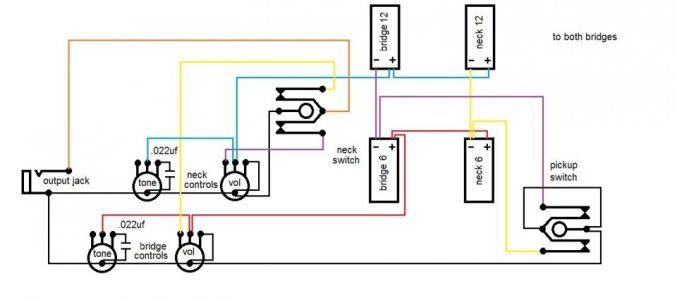Re: Double neck. 3 three way switches. 2 A500K & 2 B500K pots. Need a little help.
Re: Double neck. 3 three way switches. 2 A500K & 2 B500K pots. Need a little help.
The "T" pickups stand for "Treble"; you have one Treble (bridge) pickup for one neck and another for the other neck. Same goes for "R" pickups which stand for Rhythm (neck) pickups.
"A" potentiometers means "Audio-Taper", where the rate at which the internal resistance of the potentiometer is logarithmic. This is typically used for volume controls, with the explanation that we perceive volume changes in a logarithmic pattern. Volume controls will work with other tapers, but some people may find the control to respond weird. Audio/Logarithmic potentiometers are just the standard in this case.
"B" potentiometers are "Linear-Taper", meaning the rate of change inside the potentiometer is constant. Graphically, think of a straight line with a 1:1 ratio for the x and y axis. These potentiometers are typically used for tone controls and occasionally gain controls.
The capacitors wired to their respective potentiometers create an RC circuit, specifically a low-pass-filter, meaning the combination of a capacitor and resistor create a cutoff-frequency, and frequencies below the cutoff are unaffected, or "passed through" while frequencies above the cutoff are attenuated. This is why as you turn down the tone control, high frequencies are removed to create a darker sound. The opposite is true for a high-pass-filter: frequencies above the cutoff are unaffected, while frequencies below the cutoff are attenuated. The resistor value is changed as you turn the potentiometer - hence why another name for a potentiometer is a "Variable Resistor". Going back to tapers, a Linear "B" Taper will change this resistor value at a constant rate.
One easy way you can wire the guitar is to have a standard Gibson-style wiring (the Treble pickup having a volume and tone control, the Rhythm pickup having a volume and tone control, and a 3-way switch to select either the bridge pickup/bridge and neck pickups simultaneously in parallel/neck pickup), but the 3 way switch that toggles between the necks will be top neck/both necks simultaneously in parallel/bottom neck. Here's a wiring diagram of just that:

If you have any questions as to how any of this stuff works, we'll be more than happy to help!


